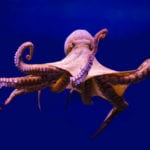 Mysteries
Mysteries  Mysteries
Mysteries  History
History 10 Surprising Stories About the Texas Rangers
 Humans
Humans 10 Philosophers Who Were Driven Mad by Their Own Theories
 Miscellaneous
Miscellaneous 10 Video-Game-Worthy Weapons and Armors from History
 Weird Stuff
Weird Stuff 10 Psychics Who Accurately Predicted Wartime Events
 The Arts
The Arts 10 Pieces of Art Inspired by a Broken Heart
 Health
Health 10 Science Fiction-Sounding New Medical Treatments
 History
History 10 Surprising Facts About the Father of Submarine Warfare
 Space
Space Ten Astonishing New Insights into Alien Worlds
 Weird Stuff
Weird Stuff 10 Bizarre Summer Solstice Rituals Still Practiced Today
 Mysteries
Mysteries Top 10 Haunting Facts About the Ghost Ship MV Alta
 History
History 10 Surprising Stories About the Texas Rangers
 Humans
Humans 10 Philosophers Who Were Driven Mad by Their Own Theories
Who's Behind Listverse?

Jamie Frater
Head Editor
Jamie founded Listverse due to an insatiable desire to share fascinating, obscure, and bizarre facts. He has been a guest speaker on numerous national radio and television stations and is a five time published author.
More About Us Miscellaneous
Miscellaneous 10 Video-Game-Worthy Weapons and Armors from History
 Weird Stuff
Weird Stuff 10 Psychics Who Accurately Predicted Wartime Events
 The Arts
The Arts 10 Pieces of Art Inspired by a Broken Heart
 Health
Health 10 Science Fiction-Sounding New Medical Treatments
 History
History 10 Surprising Facts About the Father of Submarine Warfare
 Space
Space Ten Astonishing New Insights into Alien Worlds
 Weird Stuff
Weird Stuff 10 Bizarre Summer Solstice Rituals Still Practiced Today
10 Amazing and Unexpected Ways Experts Guess the Age of Things
As the health supplement and skincare markets show, most people are interested in anti-aging. However, scientists and other experts tend to be interested in the opposite, but when they talk about aging, they do not always mean getting older. It can also mean figuring out how old something is.
Experts in many fields have gotten very good at it, using a range of unusual techniques to pinpoint the origin of things from stars and planets to pieces of music. Many people have heard that radiocarbon dating is used to age prehistoric artifacts. However, aging techniques also help scientists learn how the universe began and aid detectives in solving crimes. They even help settle court cases and calculate how many centuries sea turtles have lived. Find out how and why people do all those things and more in this list of ten amazing ways experts work out the age of things.
Related: 10 Forensic Science Tools You Didn’t Know Existed
10 Dendrochronology
Dendrochronology is the fancy name for a simple aging technique that people might even have been taught as children—counting the rings inside a tree trunk. This works because trees grow new wood every year, but it is not all the same type. Many trees grow different types of wood depending on the season. In the spring, the color tends to be lighter, while in the summer it turns darker. This is what causes the rings to appear.
But this method creates one problem, which is how to avoid what one scientist did in 1964 when he chopped down a bristlecone pine only to discover that he had just killed the oldest tree known to man. To avoid this, scientists use a device called an increment borer. This can be screwed into a tree trunk from the outside until it reaches the center, then it extracts a thin sample of the tree’s trunk, which they can use to count the rings.
Interestingly, dendrochronology is not only useful for aging trees. It has also been used to identify shipwrecks such as that of the Dolphin, an American whaler lost off the coast of Argentina in 1858.[1]
9 Static Analysis
Before people had to click the “accept” button at the end of the terms and conditions, they used to sign them on paper. Okay, they still do that for important things, but is it really any better? For example, what if somebody says that their signature must have been forged because they could not have been there to sign it on the day it is dated? Science has answers to this, too.
As well as aging wood, there are ways to age paper. Several, in fact. Different methods of coating and whitening paper have been introduced at different times, and they can go out of common use as well. By identifying which methods were used, researchers can put boundaries around the possible dates a piece of paper could have come from.
The same identification possibilities exist for ink, for which there are huge databases that detail the different types on the market and when they were in use. Such methods are known as static analysis. There are also dynamic analysis techniques that use the natural changes that occur in ink and paper over time to work out when they date from.[2]
8 Fly Life Cycles
Fly life cycles are incredibly useful to know. Not because the lives of these buzzing pests are particularly fascinating but because they can be used to help solve murders. Sherlock Holmes would surely be proud. The way it works is that forensic investigators will see what stage of their life cycle the flies on a dead body are at, then count back the days to work out when they first showed up.
The first part is done by looking at things like the flies’ size, whether they are living on the inside or outside of the body, whether they have laid eggs, and what they are eating. Using this to calculate the time of death is possible because their life cycles and behaviors are very consistent and because flies are exceptionally fast at discovering bodies.
This method can give detectives a pretty accurate idea of when somebody died, something which is a critical piece of information but one that is otherwise difficult to know in cases where the body is discovered after a long time has passed.[3]
7 Elephant Teeth
Beyond judging whether something is a child or an adult, it is difficult for regular folk to assess an animal’s age much more accurately. Experts, however, have discovered some interesting ways to get closer to the real answer. Take elephants, for example. From a distance, physical size can be a rough guide to their age, but for a more reliable answer, one has to get up close and personal. That is because the most reliable way to age an elephant is by taking a look at its teeth. Specifically, one wants to look at the molars at the back of its jaw, which it uses to chew plants.
Over its lifespan, an elephant will have six different sets of these, and it is possible to tell which set they are on. For example, if they are on their fourth set, they should be between 6 and 28 years of age. Their sixth and final set places them between 30 and 65 years old. Scientists can also look at the position of the molars and how many layers of dentine and cement surround the roots to refine their estimates.[4]
6 Skeletochronology
For some species, there is no better way of aging them than by noting their size, even inside their mouths. At least not while they are alive. One animal that has this problem is the sea turtle. Besides being able to tell whether it is a hatchling, juvenile, or adult, nothing about a sea turtle’s age can be said based on its appearance alone. In fact, even that is difficult in some cases. Female hawksbill and green turtles in the Indian Ocean can reach adult size before sexual maturity.
Hence, the age of turtles is most accurately determined after their death using a process called “skeletochronology,” which, as the name suggests, involves using a turtle’s bones to assess how long it lived. Using the humerus—a bone from the upper arm, or flipper in the case of sea turtles—scientists can tell a turtle’s age much the same way they can tell the age of a tree. Their bones contain growth rings, which can be used to calculate their age.[5]
5 Epigenetic Clocks
While scientists have come up with accurate ways of checking the age of animals, they are surprisingly far behind when it comes to their own species. AI might yet offer some solutions, but it will not change the fact that well into the 21st century, the best method for guessing someone’s age without documents is looking at them. Everything from bone growth to blood cells has been studied without success. Epigenetic clocks can get within three years of a person’s age, but they are not always accurate because what they really measure is biological age.
This is essentially how fast people are aging relative to their peers. The results can be different from their chronological age, as shown by people like biotech CEO Bryan Johnson, who reportedly reversed his epigenetic age by 5.1 years. The tests work by looking at chemical tags called methyl groups, which latch onto people’s DNA as they age. Unhealthy lifestyles can speed this up, and cutting out bad habits might slow it. This makes epigenetic clocks useful for learning about the aging process but not for solving problems like underage gymnasts or verifying world records.[6]
4 Musical Periods
Science is often used when people want to calculate something specific, like chronological age. But when they can get away with being broadly right, like narrowing a work of art down to the correct century or period, scientific methods are not necessary. Even amateurs can date them to a surprisingly accurate degree with a bit of practice. One example is classical music.
While some might think that it all sounds the same, any trained musician or fan can listen to a piece and quickly tell in which of several eras it was composed. Although it is used today as a catch-all term, “classical” actually refers to the era roughly between 1750 and 1830. Before the classical period came the Baroque era from 1600 to 1750, which was followed by the Romantic period and the 20th century.
Each era had its own unique traits. These can be as basic as what instruments are being used—some had not been invented or were more popular in certain eras. In addition, identifying in what combination, as well as what techniques the players are using and how many melodies are being played at once can help pinpoint the music’s age.[7]
3 Pinning Points
The ice caps are melting ever faster, and humans hold a lot of the blame. But how do scientists know it is their fault? One piece of evidence is that the process started and accelerated during the lifetimes of modern people. This they know from studying the “pinning points” where the ice shelves on the edges of Antarctic glaciers get stuck in shallow water. This is actually good because it makes the shelves hold back the rest of the glacier ice, preventing it from melting and flowing into the sea.
Some ice still melts, but it has to flow over these points, and this creates bumps on the surface, which can be measured by satellites. A study published in 2024 looked at changes in these bumps over three periods: 1973-1989, 1990-2000, and 2000-2022. In the first, just 15% of the bumps got smaller. In the second, it was 25%, followed by 37% in the latter. This suggests a worrying acceleration, but the study was also significant because it spotted that the process started as early as the 1970s in some places. It did not happen in many places until the 1990s.[8]
2 Radionuclides
Many things already have their own reliable clock that scientists can use to age them. All researchers have to do is figure out how to read them. One example is radionuclides, which can be used to calculate the age of space objects such as planets and meteorites. Radionuclides are atoms which release energy slowly over long periods of time. This makes them great for calculating the age of objects that contain them, but there is one problem—physical samples are needed.
Using soil from the Moon, scientists were able to tell that it is over four billion years old. If they had not had a sample, their best option would have been the older, rougher method of counting craters. This method and similar ones are still used for other planets and objects for which no samples exist.
Scientists have had better luck with stars. Although they keep a steady brightness, temperature, and size for billions of years, subtle changes in their color and spin speed offer clues. There is also “asteroseismology,” which looks at the patterns of vibrations on the surface of stars. These are different depending on whether a star is old or young.[9]
1 Old Stars and the Hubble Constant
Everybody has heard about the Big Bang and how it is supposed to have happened billions of years ago—13.8 billion at the time of writing, which is an unimaginable amount of time. But somebody did imagine it. So, how did they get there? The long answer involves the cosmic microwave background of the universe and Einstein’s theory of general relativity. Still, the estimate basically relies on two simpler ideas. One is using the oldest stars to set boundaries on how old the universe could be. Large stars burn brighter, but they also burn through their fuel quicker.
While the Sun could burn for nine billion years, a star half its size could last 20 billion. When clusters of such stars are found, scientists get an idea of how old the universe could be. Any estimates they make should fall within that range. The other idea is the Hubble Constant. This uses changes in light to calculate how quickly objects are moving away from Earth as the universe expands. With this information, scientists can work backward to figure out when the universe began, a bit like calculating when a journey began using the arrival time, distance, and speed.[10]








